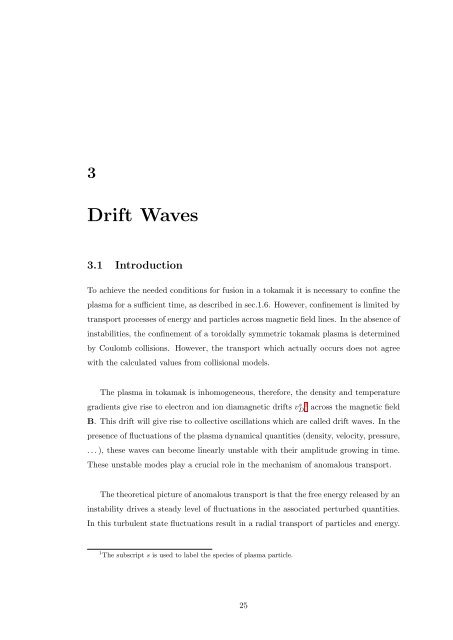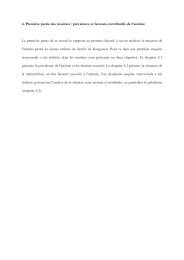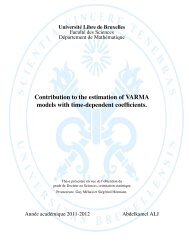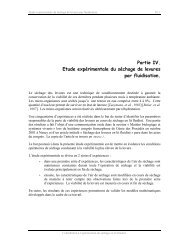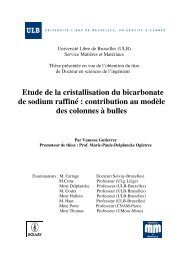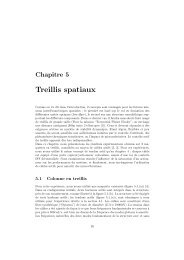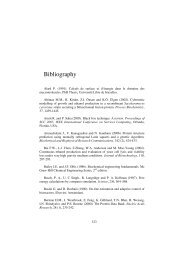- Page 1 and 2: Transport Analysis in TokamakPlasma
- Page 3 and 4: mode (ITG mode) by the impurities.
- Page 5 and 6: I dedicate my thesis to maman, baba
- Page 7: philosophical debates, exchanges of
- Page 10 and 11: CONTENTS2 Aims of the project 232.1
- Page 12 and 13: CONTENTS7 Transport Modeling of Imp
- Page 14 and 15: LIST OF FIGURES3.4 Drift of a gyrat
- Page 16 and 17: LIST OF FIGURES5.8 The peaking fact
- Page 18 and 19: LIST OF FIGURES7.9 The energy confi
- Page 20 and 21: LIST OF FIGURESxvi
- Page 22 and 23: 1. INTRODUCTION1.2 Fusion ReactionT
- Page 24 and 25: 1. INTRODUCTIONFigure 1.2: Plasma c
- Page 26 and 27: 1. INTRODUCTIONFigure 1.3: Schemati
- Page 28 and 29: 1. INTRODUCTIONIn a steady state se
- Page 30 and 31: 1. INTRODUCTION1.5) during four dec
- Page 32 and 33: 1. INTRODUCTION1.7.4.1 SawtoothWhen
- Page 34 and 35: 1. INTRODUCTIONradiation from the p
- Page 36 and 37: 1. INTRODUCTIONof the order of ∼
- Page 38 and 39: 1. INTRODUCTIONFigure 1.10: Schemat
- Page 40 and 41: 1. INTRODUCTIONδV E = δE × BB 2
- Page 42 and 43: 1. INTRODUCTIONmagnetic field geome
- Page 46 and 47: 3. DRIFT WAVESOur goal is to study
- Page 48 and 49: 3. DRIFT WAVESA Hamiltonian descrip
- Page 50 and 51: 3. DRIFT WAVES3.3.1 Equation of Mot
- Page 52 and 53: 3. DRIFT WAVESThis describes a sing
- Page 54 and 55: 3. DRIFT WAVESTaking the derivative
- Page 56 and 57: 3. DRIFT WAVESTherefore, the motion
- Page 58 and 59: 3. DRIFT WAVES3.3.3 Nonuniform E an
- Page 60 and 61: 3. DRIFT WAVESWe need to compute th
- Page 62 and 63: 3. DRIFT WAVESIf the electric field
- Page 64 and 65: 3. DRIFT WAVES3.3.5 Summary of Guid
- Page 66 and 67: 3. DRIFT WAVESwhere P is the pressu
- Page 68 and 69: 3. DRIFT WAVESprescribed as a given
- Page 70 and 71: 3. DRIFT WAVESever, in general the
- Page 72 and 73: 3. DRIFT WAVESthough the individual
- Page 74 and 75: 3. DRIFT WAVESReplacing the eq. (3.
- Page 76 and 77: 3. DRIFT WAVES∂n= −∇ · Γ (3
- Page 78 and 79: 3. DRIFT WAVES58
- Page 80 and 81: 4. DRIFT INSTABILITY ANALYSIS: LINE
- Page 82 and 83: 4. DRIFT INSTABILITY ANALYSIS: LINE
- Page 84 and 85: 4. DRIFT INSTABILITY ANALYSIS: LINE
- Page 86 and 87: 4. DRIFT INSTABILITY ANALYSIS: LINE
- Page 88 and 89: 4. DRIFT INSTABILITY ANALYSIS: LINE
- Page 90 and 91: 4. DRIFT INSTABILITY ANALYSIS: LINE
- Page 92 and 93: 4. DRIFT INSTABILITY ANALYSIS: LINE
- Page 94 and 95:
4. DRIFT INSTABILITY ANALYSIS: LINE
- Page 96 and 97:
4. DRIFT INSTABILITY ANALYSIS: LINE
- Page 98 and 99:
4. DRIFT INSTABILITY ANALYSIS: LINE
- Page 100 and 101:
4. DRIFT INSTABILITY ANALYSIS: LINE
- Page 102 and 103:
4. DRIFT INSTABILITY ANALYSIS: LINE
- Page 104 and 105:
4. DRIFT INSTABILITY ANALYSIS: LINE
- Page 106 and 107:
4. DRIFT INSTABILITY ANALYSIS: LINE
- Page 108 and 109:
5. ANOMALOUS TRANSPORT DUE TO DRIFT
- Page 110 and 111:
5. ANOMALOUS TRANSPORT DUE TO DRIFT
- Page 112 and 113:
5. ANOMALOUS TRANSPORT DUE TO DRIFT
- Page 114 and 115:
5. ANOMALOUS TRANSPORT DUE TO DRIFT
- Page 116 and 117:
5. ANOMALOUS TRANSPORT DUE TO DRIFT
- Page 118 and 119:
5. ANOMALOUS TRANSPORT DUE TO DRIFT
- Page 120 and 121:
5. ANOMALOUS TRANSPORT DUE TO DRIFT
- Page 122 and 123:
5. ANOMALOUS TRANSPORT DUE TO DRIFT
- Page 124 and 125:
5. ANOMALOUS TRANSPORT DUE TO DRIFT
- Page 126 and 127:
5. ANOMALOUS TRANSPORT DUE TO DRIFT
- Page 128 and 129:
5. ANOMALOUS TRANSPORT DUE TO DRIFT
- Page 130 and 131:
6. BENCHMARK WITH A QUASI-LINEAR GY
- Page 132 and 133:
6. BENCHMARK WITH A QUASI-LINEAR GY
- Page 134 and 135:
6. BENCHMARK WITH A QUASI-LINEAR GY
- Page 136 and 137:
6. BENCHMARK WITH A QUASI-LINEAR GY
- Page 138 and 139:
7. TRANSPORT MODELING OF IMPURITY S
- Page 140 and 141:
7. TRANSPORT MODELING OF IMPURITY S
- Page 142 and 143:
7. TRANSPORT MODELING OF IMPURITY S
- Page 144 and 145:
7. TRANSPORT MODELING OF IMPURITY S
- Page 146 and 147:
7. TRANSPORT MODELING OF IMPURITY S
- Page 148 and 149:
7. TRANSPORT MODELING OF IMPURITY S
- Page 150 and 151:
7. TRANSPORT MODELING OF IMPURITY S
- Page 152 and 153:
7. TRANSPORT MODELING OF IMPURITY S
- Page 154 and 155:
7. TRANSPORT MODELING OF IMPURITY S
- Page 156 and 157:
7. TRANSPORT MODELING OF IMPURITY S
- Page 158 and 159:
7. TRANSPORT MODELING OF IMPURITY S
- Page 160 and 161:
8. STUDY OF DRIFT WAVE CHARACTERIST
- Page 162 and 163:
8. STUDY OF DRIFT WAVE CHARACTERIST
- Page 164 and 165:
8. STUDY OF DRIFT WAVE CHARACTERIST
- Page 166 and 167:
8. STUDY OF DRIFT WAVE CHARACTERIST
- Page 168 and 169:
8. STUDY OF DRIFT WAVE CHARACTERIST
- Page 170 and 171:
8. STUDY OF DRIFT WAVE CHARACTERIST
- Page 172 and 173:
8. STUDY OF DRIFT WAVE CHARACTERIST
- Page 174 and 175:
9. DISCUSSIONthat the impurity dens
- Page 176 and 177:
9. DISCUSSIONsurface and machine wa
- Page 178 and 179:
9. DISCUSSIONthe plasma distributio
- Page 180 and 181:
REFERENCES[21] Weiland J. Collectiv
- Page 182:
REFERENCES[73] Neuhauser J. et al.


